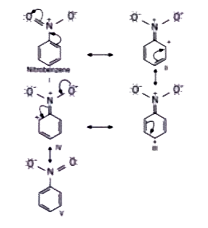Draw the resonance structures for the following compounds. Show the electron shift using curved-arrow notation.
C6H5NO2
Topper's Solved these Questions
- ORGANIC CHEMISTRY : SOME BASIC PRINCIPLES AND TECHNIQUES BOOK - ICSECHAPTER - ORGANIC CHEMISTRY : SOME BASIC PRINCIPLES AND TECHNIQUES EXERCISE - ASSERTION - REASON TYPE QUESTIONS
11 Videos
- HYDROGENBOOK - ICSECHAPTER - HYDROGENEXERCISE - NCERT TEXT-BOOK EXERCISE (With Hints and Solutions)
53 Videos
- REDOX REACTIONS (OXIDATION AND REDUCTION)BOOK - ICSECHAPTER - REDOX REACTIONS (OXIDATION AND REDUCTION)EXERCISE - NCERT TEXT-BOOK. EXERCISES ((With Hints and Solutions)
69 Videos
Similar Questions
Draw the resonance structures for the following compounds. Show the electron shift using curved-arrow notation.
C6H5−CHO
View SolutionDraw the resonance structures for the following compounds. Show the electron shift using curved-arrow notation.
C6H5OH
View SolutionDraw the resonance structures for the following compounds. Show the electron shift using curved-arrow notation.
(a) C6H5NO2
(b) CH3CH=CHCHO
View SolutionDraw the resonance structures for the following compounds. Show the electron shift using curved-arrow notation.
CH3CH=CHCHO
View SolutionDraw the resonance structures for the following compounds. Show the electron shift using curved-arrow notation.
C6H5−+CH2
View SolutionDraw the resonance structures for the following compounds. Show the electron shift using curved-arrow notation.
CH3CH=CH+CH2
View SolutionDraw the electron dot structure of the following:
O2
View SolutionDraw the structure of the following compounds:
1,2-dichlorobutane
View SolutionDraw the structures of the following compounds:
4-Chloropentan-2-one
View SolutionDraw the structures of the following compounds:
4-Chloropentan-2-one
View Solution

